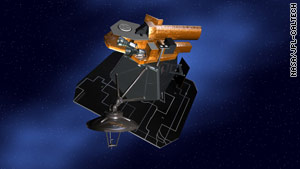Scammer
Banned

NASA is getting ready for a close encounter of the real kind with another comet next week. The Deep Impact spacecraft, already in flight, will come within 435 miles of comet Hartley 2 on November 4 in a history-making fly-by.
NASA previewed the exploratory expedition Tuesday. The space agency hopes to learn more about the formation of the solar system through the study of comets, according to Tim Larson, the EPOXI project manager at the Jet Propulsion Laboratory in Pasadena, California.
EPOXI is a loose acronym of the two science missions of which the Deep Impact craft is part: the Extrasolar Planet Observation and Characterization and Deep Impact Extended Investigation.
"Comets are considered to have some of the most pristine remnants of the material that was around when the solar system was forming. So, as our planets were forming and coming together, this is the material that was around in the solar system then. So those have been preserved in the comet, " Larson said. "We also think a lot of the water and organics on Earth were deposited by collisions with comets early on in the Earth's formation."
This will be the fifth time humans will see one of the icy celestial bodies up close, and it's the second time for Deep Impact. But this time, the spacecraft will have the best extended view ever of a comet in terms of time. It will use two telescopes with digital color cameras and an infrared spectrometer and will begin transmitting images back to Earth within about 30 minutes of the encounter, Larson told CNN Radio.
A probe from Deep Impact collided with comet Tempel 1 in July 2005, revealing material inside a comet for the first time.
Hartley 2 is not very big by comet standards, only about a half-mile wide. But Larson says that doesn't matter because the more we know about comets, the more we can learn about the solar system and about how the Earth was formed.
"What we hope to find out are what features of the comets are primordial, from when they first formed and came together, versus what features vary from comet to comet, depending on how much time they spent in the inner solar system, how often they've come near the sun and gotten modified by that interaction with the sun," Larson said. "So understanding some of those key, fundamental features of comets is what we hope to get out of this mission."
